This Special Release presents data on construction statistics from approved building permits in Quezon City for the fourth quarter of 2021. Figures are based on the preliminary results of the tabulated data from collected building permits.
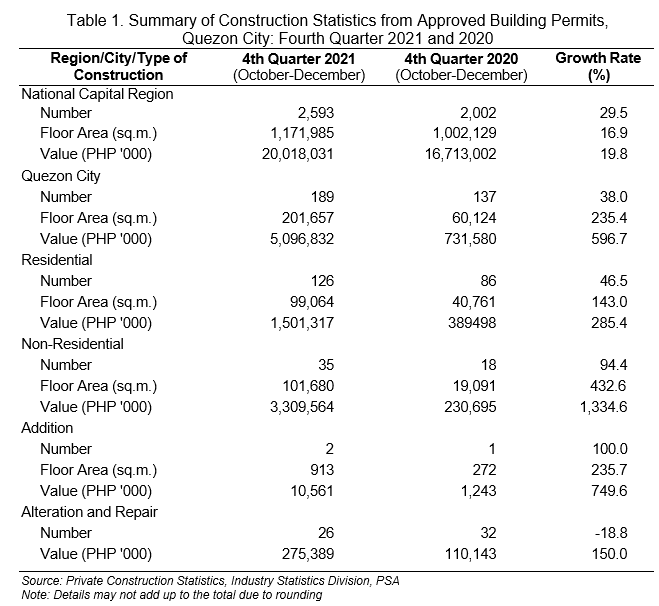
Number of approved building permits rise to 189 in the Fourth Quarter of 2021
The total number of new construction projects from approved building permits in Quezon City rose to 189 building permits in the fourth quarter of 2021 from 137 building permits in the same quarter of 2020. Similarly, the value of building construction increased from PhP 731.58 million in the fourth quarter of 2020 to PhP 5,096.83 million in the same quarter of 2021.
Relative to the entire NCR, Quezon City contributed 7.3 percent to the total number of approved building permits and 25.5 percent to the total value of construction during the fourth quarter of 2021. (Refer to Table 1 for details)
Furthermore, addition and alterations/repairs went down to 28 building permits as compared with 33 building permits in the same period of the previous year.
Figures 1 and 2 present the percentage distribution of the number and value of construction in Quezon City by type during the fourth quarter of 2021. (Refer to Table 1 for details)
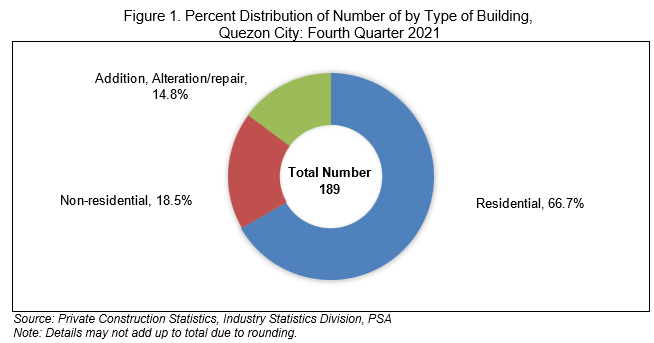
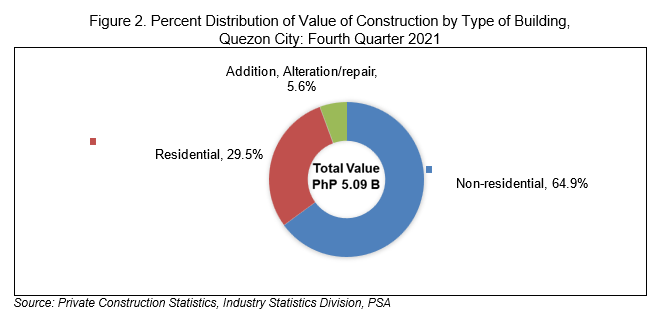
Residential type of construction contributes the highest in the total number of approved Building Permits
In terms of the number of constructions by type, residential buildings registered a total of 126 or 66.7 percent of building construction in Quezon City. Non-residential constituted a total of 35 or 18.5 percent while the remaining 14.8 percent is accounted for by additional and alteration/repair building construction with 28 applications. (Refer to Table 1 for details)
Figure 3 compares the number of constructions by type of residential building in Quezon City for the fourth quarter of 2021 and 2020.
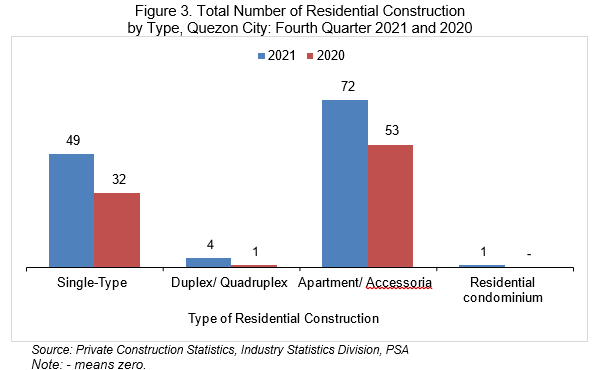
Value of construction for residential type of building marks a billion increase
The collective value of construction for residential types of buildings in Quezon City remarkably increased from PhP 389.50 million during the fourth quarter of 2020 to PhP 1.50 billion in the same quarter of 2021. Meanwhile, the value of construction for non- residential types amounted to PhP 3.31 billion in the fourth quarter of 2021, compared to PhP 230.70 million in the same period of 2020. Although residential types of buildings marked the highest in terms of approved building permits, non-residential buildings were tagged the highest in terms of value.
Furthermore, an increase in the total value of addition and alteration/repair was recorded from PhP 111.39 million in the fourth quarter of 2020 to Php 285.95 million in the same period of 2021.
Figure 4 compares the value of construction by type of residential building for Quezon City for the fourth quarter of 2020 and 2021. (Refer to Table 2 for details)
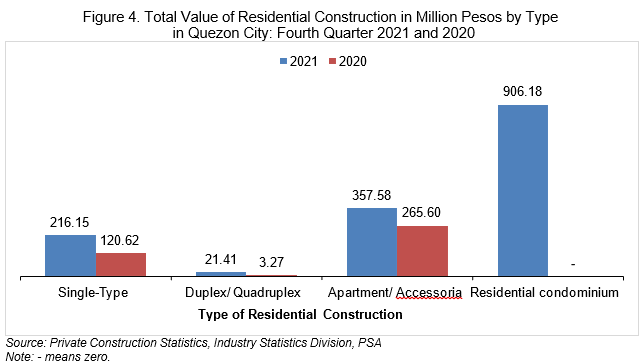
Apartment/accessoria units record the highest number; condominiums mark the highest value in Residential Building
Among the types of residential building, apartment/accessoria units registered the highest number of approved building permits in the fourth quarter of 2021 with 72 applications or
57.1 percent of the total number of residential building construction. On the contrary, residential condominiums mark the highest value amounting to PhP 906.18 million or 60.4 percent of the total value of residential building construction. (Refer to Table 2 for details)
Commercial buildings have the greatest number of approved building permits among non-residential building
In fourth quarter of 2021, the total value of non-residential buildings was estimated at PhP 3.31 billion, with corresponding 35 approved applications. Among the types of non-residential buildings, commercial buildings recorded the most number with 29 approved applications and an aggregate value of PhP 196.74 million.
Figures 5 and 6 present the number and value of non-residential building construction in Quezon City by type during the fourth quarter of 2021, respectively. (Refer to Table 2 for details)
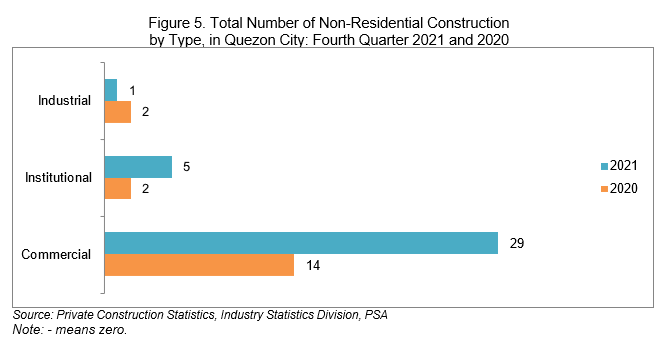
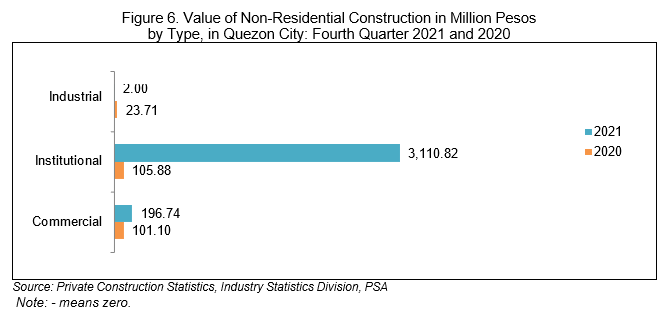
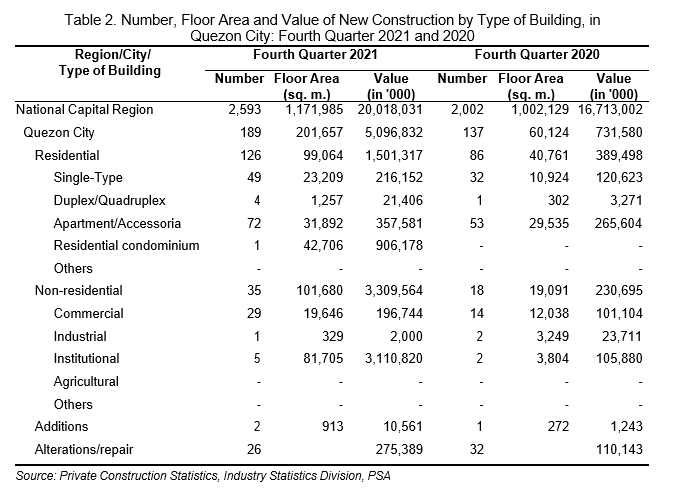
SGD HELEN L. ADOLACION
(Supervising Statistical Specialist)
Officer-in-Charge
TECHNICAL NOTES
CONSTRUCTION STATISTICS FROM APPROVED BUILDING PERMITS
Scope and Coverage
Construction statistics from approved building permits relate to administrative-based data on new constructions and additional, alterations and repairs of existing residential and non- residential buildings and other structures proposed to be constructed in all cities and municipalities of the country in a specific period.
Sources of Information
Construction statistics are compiled by the Philippine Statistics Authority (PSA) from the copies of original application forms of approved building permits as well as from the demolition and fencing permits collected every month by the PSA field personnel from the Offices of Local Building Officials (LBOs) nationwide.
Limitations
1. Data on building constructions refer to those approved applications during the reference period and not to construction work completed during the reference period.
2. The completeness of the number of building permits collected relies on the approval of applications filed with the LBOs. Hence, private building constructions without approved building permits are excluded in the tabulation of data.
Geographic Classification
Building constructions are classified and presented by geographic area using the Philippine Standard Geographic Classification (PSGC) as of December 2014. The PSGC contains the latest updates on the official number of regions, provinces, cities, municipalities and barangays in the Philippines.
Industry Classification
Construction statistics utilizes the 2009 Philippine Standard Industrial Classification (PSIC)to identify the industrial classification of the structure proposed for construction through its use or character of occupancy.
Collection
The number of building permit forms accomplished by the applicant comes in five (5) copies. The “PSA copy” of the approved building permit is made available within the first five (5) working days after each reference month. Collections of these documents from the LBO in city/municipality are undertaken by PSA field personnel within this period.
Collected documents for each month are properly checked as to its completeness by verifying the beginning and ending numbers indicated in the permit numbers. Missing numbers are indicated, with corresponding reasons, in the transmittal. In cases where there is no construction in a given month in a municipality, a certification that there was no approved building permit during the reference period is provided by the LBO to the PSA field staff.
Data Processing
Data processing of approved building permits is done both manually and mechanically. Copies of documents collected from the offices of LBOs are properly controlled, sorted, edited and coded, folioed and encoded in the PSA provincial offices. During machine validation, inconsistent and invalid entries which are flagged in an error listing are corrected in the data file. This process is repeated until there are no more inconsistent or erroneous entries found in the error listing. The data files are then forwarded to PSA Central Office for validation, consolidation and generation of preliminary tables. Data files received after the cut-off dates of submission set for each quarter are included in the generation of annual tables.
Preliminary results are based from data files that have undergone data processing in the provincial offices and have been validated at the Central Office. The preliminary tables are revised to include building permit documents received after the cut-off period in the annual tabulation.
Statistics Generated
Construction statistics generated from approved building permits provide monthly administrative-based data on building construction at the municipality level nationwide. Statistics generated are the following:
• number
• floor area
• type of construction
• value of construction
Statistical Tables
The statistical tables are presented at the regional and provincial levels by type of construction and by period according to form of ownership.
Unpublished Data
Aside from the preliminary tables posted in the PSA website, annual, quarterly and monthly statistical tables at the municipality level by type of construction and by form of ownership are available at the Industry Statistics Division of the PSA.
Other special tabulations may also be made available upon request, addressed to the National Statistician, Philippine Statistics Authority, 3rd Floor CVEA Building, East Avenue, Quezon City.
Dissemination
Preliminary and final results of construction statistics generated from approved building permits are made public in the form of Quarterly Special Releases posted in the PSA website (www.psa.gov.ph) 65 calendar days after the reference quarter and Annual Special Release, eight months after the reference year, respectively. The Quarterly Special Releases are reports containing the preliminary results of construction statistics generated 60 days after the reference quarter while the Annual Special Release is a consolidated report of the quarterly preliminary data incorporating documents which are submitted after the cut-off dates for each quarter
Definition of Terms (Adopted from the Revised and Updated IRR of the National Building Code)
Building permit is a written authorization granted by the LBO to an applicant allowing him to proceed with the construction of a specific project after plans, specifications and other pertinent documents have been found to be in conformity with the National Building Code(PD 1096).
Building refers to any independent, free-standing structure comprised of one or more rooms or other spaces, covered by a roof and enclosed with external walls or dividing walls, which extend from the foundation to the roof.
Construction refers to all on-site work done from site preparation, excavation, foundation, assembly of all the components and installation of utilities, machineries and equipment of buildings/structures.
Residential building is a building for which its major parts or more than half of its gross floor area is built for dwelling purposes. This type of building can be of the single type, duplex, an apartment and/or accessoria and residential condominium.
Single house is a complete structure intended for a single family or household, i.e. bungalow, 2-storey house, nipa hut.
Duplex house is a structure intended for two households, with complete living facilities for each; it is a single structure divided into two dwelling units by a wall extending from the floor to the ceiling.
Apartment is a structure, usually of two storeys, made up of independent living quarters, with independent entrances from internal walls and courts.
Accesoria is a one or two-floor structure divided into several dwelling units, each dwelling unit having its own separate entrance from the outside.
Residential condominium is a structure, usually of several storeys, consisting of multiple dwelling units.
Other residential construction consists of school or company staff houses, living quarters for drivers and maids, and guardhouses.
Non-residential building includes commercial, industrial, agricultural and institutional buildings.
Commercial buildings refer to office buildings and all buildings which are intended for use primarily in wholesale, retail and service trades; i.e. stores, hotels, restaurants, banks, disco houses, etc.
Industrial buildings are all buildings used to house the production, assembly and warehousing activities of industrial establishments; i.e. factories, plants, mills, repair shops, machine shops, printing press, storage plant, electric generating plants.
Institutional buildings are buildings which primarily engaged in providing educational instructions and hospital/health care; ports, airports and other government buildings; i.e. school, museums, libraries, sanitaria, churches, hospitals.
Agricultural buildings are buildings used to house livestock, plants and agricultural products such as barn, poultry house, piggeries, stables, greenhouses and grain mill.
Other non-building constructions include cemetery structures, street furniture, waiting sheds, communication towers, etc
Addition refers to any new construction which increases the height or area of an existing building/structure.
Repair is a remedial work done on any damaged or deteriorated portion/s of a building/structure to restore its original condition.
Renovation is any physical change made on structures to increase the value, quality and to improve the aesthetic.
Alteration is a construction in a building/structure involving changes in the materials used, partitioning and location/size of openings, structural parts, existing utilities and equipment but does not increase the overall area thereof.
Conversion is a change in the use or occupancy of structure or any portion thereof, which has different requirements.
Demolitions refer to the systematic dismantling or destruction of a building/structure, in whole or in part.
Street furniture are street structures consisting of monuments, waiting sheds, benches, plant boxes, lampposts, electric poles and telephone poles.
Floor area of building refers to the sum of the area of each floor of the building measured to the outer surface of the outer walls including the area of lobbies, cellars, elevator shafts and all communal spaces in multi-dwellings. Areas of balconies are excluded.
Total value of construction refers to the sum of the cost of building, electrical, mechanical, plumbing, and others. The value is derived from the approved building permit and represents the estimated value of the building or structure when completed.
For more details, please visit www.psa.gov.ph
